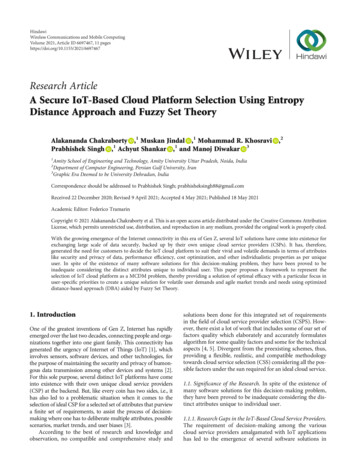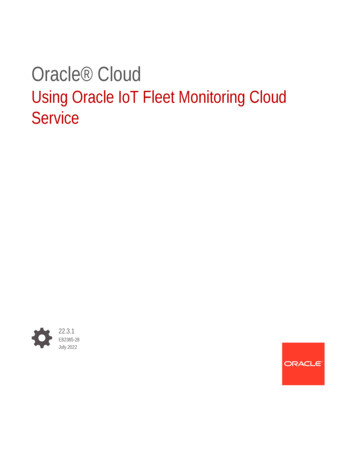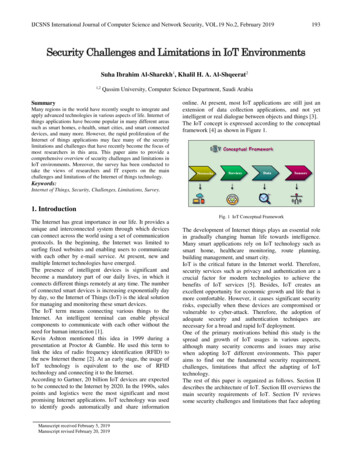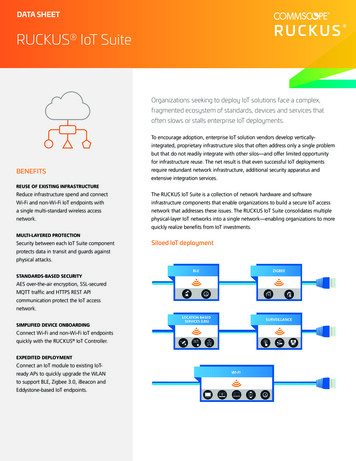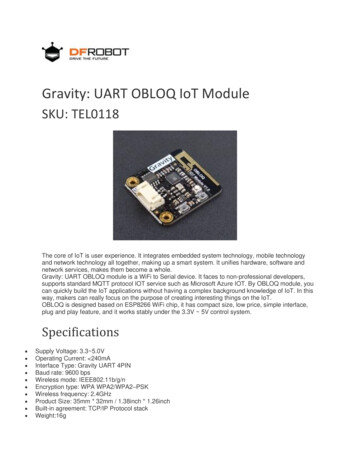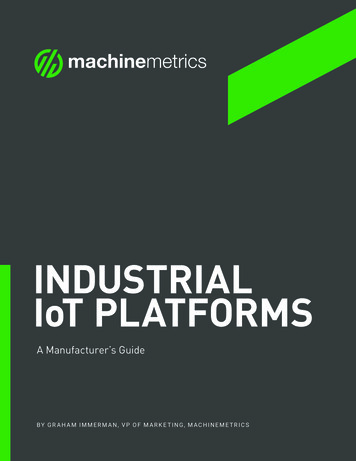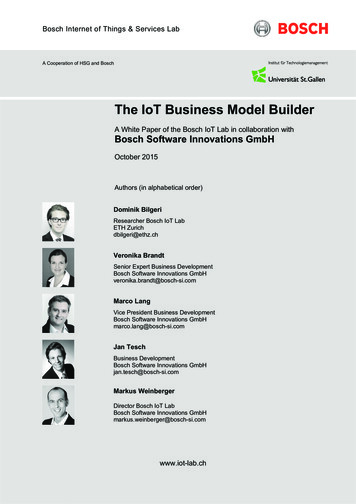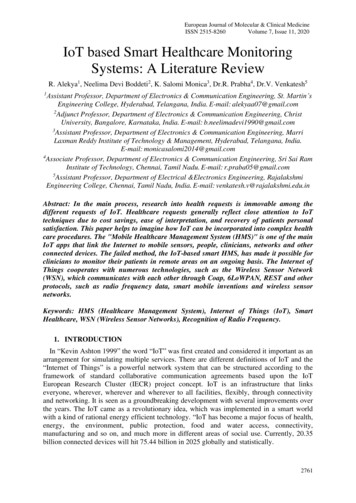
Transcription
European Journal of Molecular & Clinical MedicineISSN 2515-8260Volume 7, Issue 11, 2020IoT based Smart Healthcare MonitoringSystems: A Literature ReviewR. Alekya1, Neelima Devi Boddeti2, K. Salomi Monica3, Dr.R. Prabha4, Dr.V. Venkatesh5Assistant Professor, Department of Electronics & Communication Engineering, St. Martin’sEngineering College, Hyderabad, Telangana, India. E-mail: alekyaa07@gmail.com2Adjunct Professor, Department of Electronics & Communication Engineering, ChristUniversity, Bangalore, Karnataka, India. E-mail: b.neelimadevi1990@gmail.com3Assistant Professor, Department of Electronics & Communication Engineering, MarriLaxman Reddy Institute of Technology & Management, Hyderabad, Telangana, India.E-mail: monicasalomi2014@gmail.com4Associate Professor, Department of Electronics & Communication Engineering, Sri Sai RamInstitute of Technology, Chennai, Tamil Nadu. E-mail: r.praba05@gmail.com5Assistant Professor, Department of Electrical &Electronics Engineering, RajalakshmiEngineering College, Chennai, Tamil Nadu, India. E-mail: venkatesh.v@rajalakshmi.edu.in1Abstract: In the main process, research into health requests is immovable among thedifferent requests of IoT. Healthcare requests generally reflect close attention to IoTtechniques due to cost savings, ease of interpretation, and recovery of patients personalsatisfaction. This paper helps to imagine how IoT can be incorporated into complex healthcare procedures. The "Mobile Healthcare Management System (HMS)" is one of the mainIoT apps that link the Internet to mobile sensors, people, clinicians, networks and otherconnected devices. The failed method, the IoT-based smart HMS, has made it possible forclinicians to monitor their patients in remote areas on an ongoing basis. The Internet ofThings cooperates with numerous technologies, such as the Wireless Sensor Network(WSN), which communicates with each other through Coap, 6LoWPAN, REST and otherprotocols, such as radio frequency data, smart mobile inventions and wireless sensornetworks.Keywords: HMS (Healthcare Management System), Internet of Things (IoT), SmartHealthcare, WSN (Wireless Sensor Networks), Recognition of Radio Frequency.1. INTRODUCTIONIn “Kevin Ashton 1999” the word “IoT” was first created and considered it important as anarrangement for simulating multiple services. There are different definitions of IoT and the“Internet of Things” is a powerful network system that can be structured according to theframework of standard collaborative communication agreements based upon the IoTEuropean Research Cluster (IECR) project concept. IoT is an infrastructure that linkseveryone, wherever, wherever and wherever to all facilities, flexibly, through connectivityand networking. It is seen as a groundbreaking development with several improvements overthe years. The IoT came as a revolutionary idea, which was implemented in a smart worldwith a kind of rational energy efficient technology. “IoT has become a major focus of health,energy, the environment, public protection, food and water access, connectivity,manufacturing and so on, and much more in different areas of social use. Currently, 20.35billion connected devices will hit 75.44 billion in 2025 globally and statistically.2761
European Journal of Molecular & Clinical MedicineISSN 2515-8260Volume 7, Issue 11, 20202. LITERATURE SURVEYThe study of “IoT” was comprehensive and montages relations and constraints. The maingoal of “IoT” is to ensure that, in conjunction with “electronic sensor” devices, Internet-basedcommunications and the sending and reception of information are conventionally accessible.In a report “28.4 billion IoT users in 2017 and by 2020 they are going up to 50.1 billion”remained the result of one report. “IoT”, according to scientific charity, provides a range ofservices. “Wi-Fi, mobile phone, NFC, GPS etc.” is continuity of contact. The IoT main aim,though, is to incorporate organizations, mechanization so that messages can be transmittedwithout interruptions, compared to software creation; the start of the programmed is the mostfrequently recycled sensors with accelerometers, compression-embedding camps such as the“MCUS, MPUs”. The services have improved “intelligent fitness, transportation, grids,parking and intelligent homes.” Therefore, the core goal of IoT is to combine organizationsand mechanization in order to provide messages continuously. The initial opinion for the“IoT phase is divided into criteria, specifications and implementation” is comparable tosoftware development overall. An essential method is the final section containing thecompany process. “H.” In order to understand the specifications of any IoT project Eskelinensubmitted two questions and included them in the design phase. These moments of designbased science lead to adequate exploration of the following concepts, before the constructionis funded, a strategy needs to be created that blends realistic goals with theory, and one has tobear in mind at the same time that real life is a research centre. Systematic and professionaltesting methods should be carried out. The designs should always be taken into account forany failure, and the designs chosen should be demonstrated to be durable over time. WhileSaini et.al developed its healthcare system, the consumer was the subject of the study: theprogrammed specifications used a basic design methodology similar to typical softwaredevelopment courses. The WSN is a significant part of IoT, and it also plays an importantrole in its healthcare applications. They are known for their high-end and miscellany wirelesscontrol systems over other regular devices. Working on the WSN for pulse rates and oxygensaturation was emphasized by Rotariu and Manta in 2012. Yuehong etc., on the other hand,and ECG and blood pressure sensors mounted on the mobile telephone in 2016. With the IoTapproach in the health analogy, the wireless network improves, he said. Tan et.al used Wi-Fitechnology for its 2012 work in the control area to relay messages on different bodyfunctionality, such as blood pressure, pulse rate, body temperature and oxygen saturation.J.J.R. and Wannenburg. Bluetooth was introduced into the smart phone by Malekianc to trackpatients further.3. IOT IN HEALTHCAREBy introduction of 'IoT' it has been possible to distinguish between 'health data' in theanalyzing and diagnostic of a physician after systems of physical sensors. The biggest benefitof the 'IoT in healthcare' is to reduce maintenance burden, followed by an increase in thechance of healthcare. The addition individual and online health care network was greatlearning experience and anticipated that mobile information and general technology killingapplications would lead to the development of cloud health services. IoT is already offered asa primary platform for neurological awareness monitoring. Because effective surveillancedevices are not available, it is possible to take many higher risks. Technologies such as IoTare played here. The best interest of the patient is such caution. Multiple sensors are used toanalyze patient details. The caregiver can provide adequate guidance on health care.Increased monitoring is required for IoT devices commonly used for disabled patients.Monitoring strategies, through the assistance of the sensors, have been collected to maintain aconstant material movement by the patients referred to there for caregivers. In turn, this2762
European Journal of Molecular & Clinical MedicineISSN 2515-8260Volume 7, Issue 11, 2020enhances care quality. In the end, this leads to care costs. The figure below shows how IoTplays a major role in healthcare.Fig. 1 IoT in Healthcare Monitoring SystemsThe Architecture of IoT in HealthCareIoT is a network of physical object-linked devices that allow remote devices to hear,analyze, and monitor. The computational mechanism for linking computer hardware to allowcommunication between sensors and smart sewing equipment. IoT implementations in IoTdata processing rely heavily on the middleware layer. Smart grid, clever city, clever home,clever agriculture, clever communications. are all other IoT systems. The three-layer IoTarchitecture is based on the layers of understanding and networking. It is further expanded toinclude middleware and business applications.1. Perception layer: The sensory and physical instruments are identified in the cognitivelayer. The perceptual layer sensor system points to and then detects an object and collectsobject information. Information on temperature, mobility, position, moisture, vibrations,distance, speed, chemical changes etc can be collected according to the kind of sensor.The information is then passed to the next processing layer. When a lady wears fixedearrings which are clean to her ears and help diagnose various organ conditions and win awoman's position? The viewing layer transmits the collected data to the processingnetwork layer through the node.2. Perception Layer:The “Broadcast Layer” is often named, with its key purpose being toconnect various waiters, intelligent objects and network devices. Collect sensor data onsensor devices transmits. The system of communication can be infrared, Bluetooth,ZigBee, Wi-Fi, UMTS and 3 G technologies. After network layer coating, the information2763
European Journal of Molecular & Clinical MedicineISSN 2515-8260Volume 7, Issue 11, 2020from the core is then moved to the middleware layer, which transfers the informationfrom the core to the front of the working layer.3. Middle wave Layer: Experiencing the enormous amount of data obtained from thenetwork layer is the big processing layer that stores it. The data base communication andresource management are responsible, because it is in the middle layer and provides thelower layers with a service layer. To process vast quantities of data links it with Big Dataand Cloud computing. Body temperature analysis and checked is performed on dataobtained by earrings. In a sector which is reliable and similar to the customer, if there is adifference in the average temperature.4. Application Layer: An essential aspect of this layer is to provide end-users withapplication-oriented services. That is because the layer explicitly interacts with the enduser by having application layers. When the information has been obtained on theearrings of a lady, tell you that you have fever and you can contact the lady in question onthe application form. This is a layer that communicates with the user by sending a smartphone message about the flu.5. Business Layer: The corporate layer controls the whole eco-business model of IoT. Ithelps end users decide more efficiently. For example, a person with fever would suggestdetails in your closest clinic or hospital.Wearable DevicesFor things such as bracelets, ornamentation, patches, caps, t-shirts (t-shirts), bands, glassesWearable processes can be tailored to the "real body." This equipment has been used tocontact the person who monitors the disease, personal health and the information gatheredwhich has been sent to the central and internal research centre. Three elements are wearabledevices such as cameras, machine buildings and exhibits. Wearable devices may providenatural statistics, including calories, steps, heart rate, blood pressure; time spent exercising,and so on. The effect on these devices is enormous and of course very strong, which has agood focus on monitoring the physical health of our users.Various wearable devices as given below: Pulse Oximetry: The unit tests the oxygen saturation level of the human body andmonitors the difference in the skin blood flow associated with the cardiac cycle. Thepump oximeter, containing an image detector and light-emitting diodes (LEDs), isconnected to the finger or ear. The red light sent or carried back into the human body testsinfrastructure. The distinction between the level of the installation and the amount ofdeoxygenated hemoglobin helped to measure oxygen saturation. It is used to calculate theheart rate as Photo Plethysmo Graph (PPG). Electrocardiography (ECG): A waveform that monitors the heart continues to functionand provides time information. There is also restricted readiness for automation for ECGcalculation based on wireless sensor devices. Blood Pressure: The energy used by blood pumping into the blood vessels helps toquantify it. The oscillometric approach is used to calculate these types of sensors for thehand frame and systolic readings. Electromyography (EMG): The muscle research works by looking at the muscle'selectrical signals. For all electric signals EMG is the spatio-temporal DRM. The EMGsignal therefore provides an efficient way to monitor human muscles' activities. Electroencephalography (EEG): EEG is a representation of human brain functions.Wireless Intelligent Sensor (WISE) is a low-frequency control device equipped for EEGdata acquisition, wireless communication and analogue signal synchronizationapplications, and low-level real-time signal processing.2764
European Journal of Molecular & Clinical MedicineISSN 2515-8260Volume 7, Issue 11, 2020Implantable DevicesUnder the jar of the human body and the help overhaul part or structure are insertedArtificial Implants. Implants are more widely used for multiple applications including neuralprosthesis, orthopedics, heart stent, artificial pacemakers, etc. Any organic material such asapatite, silicone, titanium can be extracted from the outside layer of the implanted equipment,and the contents must be chosen according to the human body’s specifications. Ceramics,metals and polymers may be manufactured from materials used for artificial devices. Thefollowing are other equipment listed: Glucose Monitoring: A mixed membrane in the tumor tissue is the competent procedurefor the implantation of the sensor. During the 30s, body sugar levels can be tracked anddata transmission occurs every 5 minutes. When the sensors are in place and the level ofglucose can be regulated, an alternative to the insulin level is given. Implantable Neural Stimulators: These types of electrical stimulation trigger electricimpulses to relieve chronic pain in the human spinal cord or brain.Applications of IoT in HealthcareApplications to healthcare allow patients and adults to live independently. IoT sensors areused during this period for diagnosing and re-evaluation of their wellbeing and sending alertsin unlawful circumstances. The IoT device itself will advise the patient appropriately whenother minor problems are detected". "The sections below cover the different IoT uses inhealthcare.Fig.2 Applications of IoT in HealthcareThey are split into two general types of health applications made for IoT: single step andmixed mode, as seen in Figure 3.i. Single status applications: such applications designed for a specific disease.2765
European Journal of Molecular & Clinical MedicineISSN 2515-8260Volume 7, Issue 11, 2020Fig.3 Classification of applications in IoT based Healthcare Glucose Sensitivity: Diabetes is a metabolic condition if the sugar level at a long-termperiod is above average. The blood sugar control system generates blood glucose of somekind and helps to prescribe a healthy diet, appropriate tests and medications. It iscurrently proposed an m-IoT configuration process that is not permitted based on glucose.To this end, different sensors are linked in patients through the correct provider of IPv6connectivity. In the operating system, it creates an IoT-based communication unit thattransmits the information gathered to the level of blood sugar. A collector of glucose, acomputer or a smart phone and the processor is included in this package. A standard IoTbased detector for glucose levels is also proposed. Blood Pressure Monitoring System: High blood pressure shows the heart pumpingthrough the body powerfully. The method of IoT promotes the diagnosis and treatment ofhealth problems, including blood pressure (BP), hemoglobin (HB), levels of blood sugarand abnormal cell growth. An IoT system for blood pressure, diabetes and obesitytreatment. Body Temperature Monitoring: Body temperature control and tracking is an essentialcomponent in health applications. The homeostasis change depends on the temperature ofthe body, based on the m-IoT principle. Telos Bmote software body-sensor sensors haveclear and efficient internal performance. On the top of an IoT unit, the body temperaturecontrol device is centered on the home port. It supports the control and calculation of thetemperature infrared detection and RFID module. Oxygen Saturation Monitoring System: The Pulse oximeter is used to measure oxygenin the blood continuously. The use of IoT with pulse oximetry is useful for technicalapplications. The benefit of IoT-based pulse oximetry is addressed by coAP-based healthcare system studies. Ninin shows the function of the Wrist OX2 oximeter machine. Thissystem is wired to Bluetooth and links the sensor directly to Monere. To track remotepatients, an IoT-based norm and low-pulse oximeter is used. The IoT network allows thissystem to continuously monitor the health of patients. ECG (Electrocardiogram) Monitoring System: The ECG monitoring unit has theoption of displaying the user / patient ECG waves. A patient's medical report is publishedby gathering ECG signals and uploading data to the cloud network. Provides user inputon the basis of the collected information. With a traditional analogue to digitaltransformer, the IIo-OTG microcontroller transforms ECG signals and downloads abinary file output from the cloud network for analysis and identification of irregular2766
European Journal of Molecular & Clinical MedicineISSN 2515-8260Volume 7, Issue 11, 2020 conditions for human health. The full advantage of these machines decreases waitingtimes and decreases facilities in hospitals and emergency departments.ii. Consolidated status requests: These applications can treat certain diseases together.Wheelchair Management System: Comfortable wheelchairs are suggested by experts tosave the lives of the elderly and individuals with disabilities. IoT plays a significant rolein speeding up this process in this region. Smart wheelchairs are fitted with differentsensors to track seat movement and also to display the status of patient / user.Rehabilitation System: The process of regenerating population growth issues and a lackof life skills can be improved by IoT. The capabilities of physically disabled people canbe strengthened. In order to strengthen the recovery mechanism, the Body SensorNetwork was introduced. Ontology-based automation architecture reveals that IoT can bea great way to manage information in real time. The Early Childhood Educationprogrammed, the intelligent city medical recovery programmed and the integrated goaltechnology programmed are many of the services that IoT has created.Healthcare Solutions Using Smartphone: The electronic device control system withsensors has so far been seen on the Smartphone. Specific mobile applications are offeredin the healthcare sector to support patients, provide medical training and provide initialtraining. A range of software and hardware products that portray the Smartphone as auseful tool in healthcare are being developed. Table 1. Offers a list of the most populargeneral health mobile apps.Table 1: Healthcare Applications using Smartphone4. CONCLUSIONIn this article, IoT was defined as main distributor of health care systems as one of IoTmost important uses. Helps to better to provide people with healthcare at any time in anyregion by eliminating geography, time and other barriers while increasing their coverage andefficiency at the same time. The IoT health revolution is a reality and thus fair, affordablecare provides high-quality care to people. These applications produce large quantities ofsensor data to be handled properly for monitoring and handling. Cloud computing, through itsBase, is a promising approach for efficient knowledge processing in the health sector. Theframework provided is special and can be used to handle cloud device and network dataspecific to a patient. Built on IoT and its design principles, the cloud app allows for directcommunication of sensor devices while at the same time making it versatile and effective toserve stored data, users and sensors. Wireless sensor networking in which single access isprovided to embedded sensor control systems and the complete system service. This paperthrives to lead to a fully integrated IoT-based health care system and acknowledges the needto integrate the various IoT services further. Further work on safety issues in relation to thedifferent implementation phases needs to be completed.2767
European Journal of Molecular & Clinical MedicineISSN 2515-8260Volume 7, Issue 11, 20205. REFERENCES[1] Saranya. E, Maheswaran. T, “IoT Based Disease Prediction and Diagnosis System forHealthcare”, International Journal of Engineering Development and Research (IJEDR) Volume 7, Issue 2 ISSN: 2321-9939, pp.232-237, 2019.[2] M.M. Dhanvijay and S.C. Patil, “Internet of Things: a survey of enabling technologies inhealthcare and its applications,, Computer Networks, vol. 153, pp. 113–131, 2019.[3] Shah Nazir, Yasir Ali, Naeem Ullah, and Iv anGarc ıa-Magariño, “Internet of Things forHealthcare Using Effects of Mobile Computing: A Systematic Literature Review”,Hindawi Wireless Communications and Mobile Computing, Article ID 5931315, 20pages, Volume 2019.[4] Mohammad Dawood Babakerkhell, Nitin Pandey, “Analysis of Different IOT BasedHealthcare Monitoring Systems”, International Journal of Innovative Technology andExploring Engineering (IJITEE) ISSN: 2278-3075, Volume-8 Issue-6S2, April 2019.[5] H. Ahmadi, G. Arji, L. Shahmoradi, R. Safdari, M. Nilashi, and M. Alizadeh, “)eapplication of Internet of things in healthcare: a systematic literature review andclassification, Universal Access in the Information Society, vol. 18, no. 4, pp. 837–869,2019.[6] Dr.T. Poongodi, Dr. Balamurugan Balusamy, Dr.P. Sanjeevikumar, Dr. Jens Bo HolmNielsen, “Internet of Things and E-Healthcare system-A Short review on challenges”,IEEE India info.vol.14 No. 2, pp. 143-147, 2019[7] Smiju Sudevan, Mani Joseph, “Internet of Things: Incorporation into HealthcareMonitoring”, IEEE, 2019.[8] M.M. Dhanvijay and S. C. Patil, “Internet of Things: A survey of enabling technologiesin healthcare and its applications,’ Computer Networks, vol.153, pp. 113-131, 2019.[9] M.M.E. Mahmoud et al., “Enabling technologies on a cloud of things for smarthealthcare,” IEEE Access, vol. 6, no. c, pp. 31950-31967, 2018.[10] R Sangeetha, Dr.R. Jegadeesan, M P Ramya and G Vennila, “Health Monitoring SystemUsing Internet of Things”, International Journal of Engineering Research and AdvancedTechnology (IJERAT), E-ISSN: 2454-6135, Volume.4, Issue 3 March-2018.[11] Dziak, D., Jachimczyk, B., &Kulesza, W.J., “IoT-based information system forhealthcare application: design methodology approach”, Applied Sciences,7(6),596, (2017).[12] J. Qi, P. Yang, G. Min, O. Amft, F. Dong, and L. Xu, “Advanced internet, of things forpersonalized healthcare systems: A survey,” Pervasive Mob. Computer. vol. 41,pp. 132-149, 2017.[13] S.B. Baker, W. Xiang, and I. Atkinson, “Internet of Things for Smart Healthcare:Technologies, Challenges, and Opportunities,” IEEE Access, vol. 5, no. c,pp. 26521-26544, 2017.[14] Yuehong, Y.I.N., Zeng, Y., Chen, X.,& Fan, Y., “The internet of things in healthcare:An overview”, Journal of Industrial Information Integration,1, 3-13, (2016).[15] Ejaz, W., Anpalagan, A., Imran, M.A., Jo, M., Naeem, M., Qaisar, S.B. and Wang, W.,“Internet of Things (IoT) in 5G wireless communications”, IEEE Access, vol.4,pp.10310-10314, 2016.[16] A.B. Pawar and S. Ghumbre, “A survey on IoT applications, security challenges andcountermeasures,” in Proceedings ofthe 2016 International Conference on Computing,Analytics and Security Trends (CAST), pp. 294–299, Pune, India, December 2016.[17] Ejaz, W., Anpalagan, A., Imran, M.A., Jo, M., Naeem, M., Qaisar, S.B. and Wang, W.,“Internet of Things (IoT) in 5G wireless communications”, IEEE Access, vol.4,pp.10310-10314, 2016.2768
European Journal of Molecular & Clinical MedicineISSN 2515-8260Volume 7, Issue 11, 2020[18] S. Kraijak and P. Tuwanut, “A Survey on IoT Architectures, Protocols, Applications,Security, Privacy, Real-World,”11th Int. Conf. Wireless. Commun. Netw. Mob. Comput.(WiCOM 2015), pp. 1-6, 2015.[19] S.M.R. Islam, D. Kwak, M.H. Kabir, M. Hossain, andK.-S. Kwak, “Internet of Thingsfor health care: a comprehensive survey,” IEEE Access, vol. 3, pp. 678–708,2015.[20] Islam, S.R., Kwak, D., Kabir, M.H., Hossain, M. and Kwak, K.S., “The internet ofthings for health care: a comprehensive survey,” IEEE Access, vol.3, pp.678-708, 2015.[21] Borgia, E., “The Internet of Things vision: Key features, applications, and open issues”,Computer Communications, 54, 1-31, (2014).[22] Saini, A., &Yammiyavar, P., “Weak eyesight therapy: A case study in designing anapplication for m-health systems”, In Human Computer Interactions (ICHCI), 2013International Conference on (pp. 1-8). IEEE, 2013.[23] Rotariu, C., & Manta, V., “Wireless system for remote monitoring of oxygen saturationand heart rate”, In Computer Science and Information Systems (FedCSIS), 2012Federated Conference on (pp. 193-196). IEEE, 2012.[24] Tan, S.L., Garcia Guzman, J., & Villa-Lopez, F.H., “A wireless body area network forpervasive health monitoring within smart environments”, In Consumer ElectronicsBerlin (ICCE-Berlin), 2012 IEEE International Conference on(pp.47-51). IEEE, 2012.[25] Bui, N., &Zorzi, M., “Health care applications: a solution based on the internet ofthings”, In Proceedings of the 4thInternational Symposium on Applied Sciences inBiomedical and Communication Technologies (p. 131). ACM, 2011.[26] Ning, H., & Wang, Z., “Future internet of things architecture: like mankind neuralsystem or social organization framework?”IEEE Communications Letters, 15(4), 461463, 2011.[27] Pantelopoulos, A., & Bourbakis, N.G., “A survey on wearable sensor-based systems forhealth monitoring and prognosis”, IEEE Transactions on Systems, Man, andCybernetics, Part C (Applications and Reviews),40(1), 1-12, (2010).[28] A. Pantelopoulos and N. G. Bourbakis, A Survey on wearable systems for monitoringand early diagnosis for the elderly, IEEE Transactions on Systems, Man andCybernetics, Part C: Applications and Reviews, vol. 1, pp. 1-12, 2010.[29] D. Dakopoulos and N.G. Bourbakis, Wearable obstacle avoidance electronic travel aidsfor visually impaired: A Survey, IEEE Trans on Systems, Man and Cybernetics, vol. 40,pp. 25-35, 2010.[30] O.G. Morchon, H. Baldus and D.S. Sanchez, Resource Efficient Security for MedicalBody Sensor Networks, Wearable, and Implantable Body Sensor Networks, BSNInternational Workshop, 4, pp, Apr 2006.2769
IoT is a network of physical object-linked devices that allow remote devices to hear, analyze, and monitor. The computational mechanism for linking computer hardware to allow communication between sensors and smart sewing equipment. IoT implementations in IoT data processing rely heavily on the middleware layer. .
